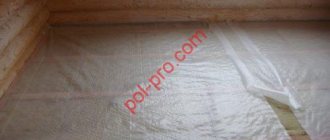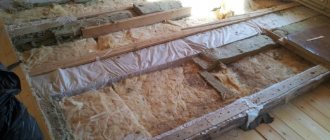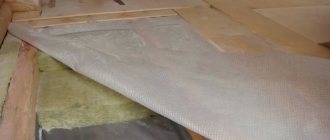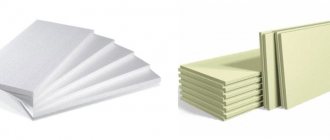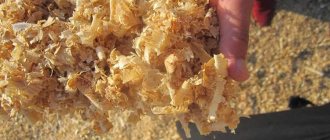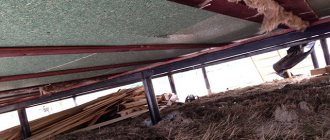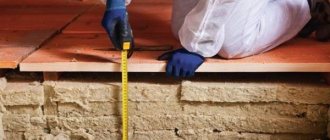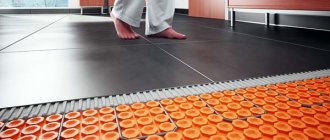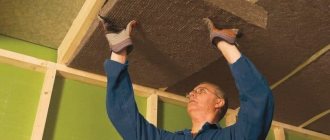In order to leave your answer to a question, you must log in or go through a quick registration procedure Register!
Heated floors have proven themselves well in our conditions, moving from the category of eccentricities of those who have nowhere to put their money, into a completely utilitarian solution to the heating problem for mass developers. What is attractive is not only the significantly increasing level of indoor comfort associated with the disappearance of poorly heated zones below the level of heating devices, but also the absence of temperature contrasts between the overheated upper layers of air and the cool lower ones. In addition, the installation of a heated floor is possible in a variety of options, from exclusive systems to a very simple economy class.
The heat source is electrical heating elements or recessed pipes connected to a water central heating system. The use of heating cables is much more convenient and cheaper to install and maintain. They do not pose the risk of fluid leakage from the system, dampness or leakage to lower levels. The level of risk of electric shock during operation can be regarded as minimal, since safety of use is the most important criterion in the development and production of such systems.
Oborgev based on the “warm floor” principle has shown its economic feasibility. An improved subjective feeling of warmth by a person in a room allows heating energy costs to be reduced. However, this advantage can be realized when the system itself is designed correctly and the heat generated is not spent on heating the floor panels, walls, and especially the street.
One of the successful options for installing a heated floor over an unheated room with a monolithic or prefabricated floor slab can be considered a design that includes a layer of structural, extruded polystyrene foam. Sufficient thermal insulation will be provided by a two-centimeter thick sheet of material specifically designed for floor insulation. Increased density and rigidity allows it to withstand the necessary operating loads, while simultaneously maintaining very high thermal performance.
Low heat loss in the direction of the insulation layer when the heating element is turned on directs the distribution of thermal energy towards the room, and not the ceiling. The heated floor surface effectively radiates it into space and participates in the conventional exchange of air layers. Even when the heater is turned off, this layer significantly increases the thermal inertia of the room, preventing it from cooling through heat loss towards materials with a high thermal conductivity gradient.
The design of the “warm floor” is made multilayer. Each element performs its own function. The layers are arranged in the following order, listed from bottom to top:
- a layer of extruded polystyrene foam two centimeters thick;
- polyethylene film;
- cement-sand screed into which a system based on a heating cable is installed;
- clean floor made of materials with high thermal conductivity.
Expanded polystyrene sheets are laid on a previously cleaned base, which can be primed with a primer or diluted adhesive used when installing the slabs. The adhesive solution is applied to the lower surface of the insulation, which is installed on the base so that the outer surface forms a flat horizontal plane.
A polyethylene film with a thickness of two tenths of a millimeter is laid on top of the sheets of expanded polystyrene. It not only acts as a barrier layer between the insulation and the cement-sand screed, but also functions as a vapor barrier. The film will protect the screed from the penetration of water vapor from the unheated floor into the layer of cement-sand screed, which is especially important when the heating elements are turned off.
A layer of cement-sand mortar one and a half to two centimeters thick is applied to the film, into which heating elements, a heating cable with all associated fittings are embedded. After which a covering and leveling layer of the same material is applied. The heating cable is enclosed in a screed with a total thickness of five to six centimeters.
The finished floor covering is laid along the screed onto a layer of adhesive mortar. To do this, it is best to use tile material based on ceramics or natural stone. You should not use wood or other coverings with low thermal conductivity, as they will negate the thermal efficiency of the heater and the entire structure.
Methods for insulating the floor above the basement
There are two ways: treat the basement ceiling with heat-insulating material and insulate the ceiling on the side of the house. In the first case, the choice of insulation is small: either sheet/plate materials that are glued to the ceiling and fixed with mushroom-shaped dowels or nails, or sprayed liquid polyurethane foam.
When insulating the ceiling from above, various bulk substances are also used.
In addition to installing thermal insulation in the house, you can install a “warm floor” system, water or electric. The design of a heated floor pie also includes waterproofing and insulation - otherwise, most of the heat from the cable or pipes will go into the basement.
Insulation
Types of insulation
Both bulk and rolled or slab materials are used as insulation. Bulk insulation materials include expanded clay, vermiculite, slag, mineral fibers, and shavings.
Backfilling with expanded clay
Plate materials are factory-made slabs or blocks made from materials with low thermal conductivity. Recently, polyurethane foam insulation, which is blown into the space of the insulated structure, has become very popular.
Mineral wool insulation
But the most popular, especially in private construction, are flexible, soft materials. Such insulation materials are good because they are easy to give the required shape and are convenient to install. The most common insulation is the so-called mineral wool in the form of mats or rolls.
Advantages of mineral wool insulation:
- good thermal conductivity;
- non-flammable and does not support combustion;
- lightweight, saving on load-bearing structures;
- convenience and speed of installation.
Flaws:
- hygroscopicity;
- a base for installation is required.
What material can be used to insulate the floor?
Here is a list of materials that can be used to insulate the floor above an unheated basement on the side of the house:
1. Expanded polystyrene with a density of 35 kg per cubic meter, including extruded. Excellent thermal insulation properties, water resistance, vapor tightness, ease of installation, low price.
Special profile mats are made from EPS for laying heated floors.
Disadvantages of the material: flammability and toxicity when burning.
2. Mineral wool (usually basalt). Also high-quality insulation, non-flammable, environmentally friendly, easy to process and inexpensive. Disadvantage: hygroscopicity. When wet, most of the heat-protective properties are lost. When installing mineral wool thermal insulation, it is necessary to lay a vapor barrier membrane on top, because cotton wool is a vapor-permeable material.
3. Expanded clay. Bulk material, baked clay granules. Non-flammable, environmentally friendly, cheap. Light weight, can be used to insulate wooden bases. It is used both separately and as part of a concrete screed.
Disadvantage: hygroscopicity. When wet, the weight increases and the load on the floor increases.
4. Ecowool – fluffed cellulose. Ease of processing, environmental friendliness, resistance to damage by rodents and fungus. Does not shrink, does not lose heat-protective properties when wet. It does not support combustion, but smolders. Used dry and in solution. Disadvantage: installation requires special pumping equipment.
5. Sawdust. Environmentally friendly, cheap and warm material. Cons: flammability, hygroscopicity. In its pure form it is susceptible to rotting, damage by rodents, insects, and fungus. Used as a mixture with lime and gypsum or with clay.
6. Liquid polyurethane foam. It is applied from a spray gun in an even layer over the entire surface of the base, forming a sealed, even coating without voids.
Can be applied to a reinforced concrete slab, to a subfloor or between joists. Disadvantages: flammability (G1, G2), susceptibility to destruction by UV rays, a spray gun is required for application, the price is not too low.
Most insulation materials can be laid either under a concrete screed or without it. In this case, the choice depends on the base material: you cannot place a screed on a wooden floor, it will not support the weight of concrete. Screed is a common design element for heated floors if they are installed on top of a concrete slab.
Building with a basement area
Owners of private buildings intended for permanent residence often think about how to cheaply insulate the floor and not spend a lot of money on the work. There is no need to save too much. Inexpensive insulation made from low-quality materials will lead to only one loss. But you shouldn’t carry out complex work where you can realistically do without them. Unfortunately, this cannot be done in buildings with a basement.
Since soil masses usually freeze to a significant depth, insulators must be installed in areas where there is maximum exposure to cold. The best option is external thermal insulation of basement walls. This will prevent the soil from coming into contact with the wall surface.
A good insulation option is extruded polystyrene foam. This is not to say that it is very expensive, but you cannot call it cheap either, since a large number of products have to be used on site. Expanded polystyrene boards have all the necessary properties to reliably protect the base from freezing. It is advisable to carry out the insulation itself along the entire height of the supporting structure.
The correct calculation of the thickness of the insulating material is calculated based on many characteristics, from the type of soil mass to the depth to which the soil freezes. When polystyrene foam is used to cover the underground areas of the foundation, they are subsequently backfilled with soil. The basement area can be finished with any suitable material. It serves as the final decorative and protective layer of the insulation system.
Floor insulation technology above the basement
With any insulation method, waterproofing is first laid. Ordinary polyethylene film is suitable for this purpose. Adjacent strips are overlapped and secured with mounting tape. An overlap on the walls is definitely needed. Its height depends on the thickness of the cake, including the screed, if any.
You can use PVC film as a waterproofing material.
Further installation depends on the type of insulation and base:
1. On a flat base, the insulation boards are laid out end-to-end on the floor and connected to each other with tape.
2. When laying on wooden joists, the slabs are placed between the joists face to face; fixation is not necessary.
3. When pouring the screed, another layer of waterproofing is laid on top.
4. When installing heated floors, a layer of foil is placed under the pipes/cables on top of the insulation, which reflects all the heat from the system into the room.
5. It is most convenient to place bulk materials between the joists and cover them with subfloor boards on top: this way they do not reduce the height of the room. When installing on a flat base, wooden partitions are installed instead of joists, on which the subfloor boards will then rest.
6. Before pouring the screed, a waterproofing membrane (preferably PVC) must be laid on top of the expanded clay. The screed is poured along the beacons and leveled using the rule.
7. When installing a screed over a heated floor system, it is necessary to lay a damper tape around the perimeter of the room, otherwise the concrete will crack when heated.
8. Composition of the sawdust mixture: 85% is sawdust, 5 – gypsum, 10 – lime. The components are mixed dry, then diluted with water. The recommended layer is 25 centimeters.
Sawdust screed is not used for heated floors. It should be fenced off from the stove with refractory bricks.
The finishing coating can be anything: planed boards, linoleum, parquet, laminate, ceramic tiles. Some of them require a solid base. If there is no screed, you can use chipboard or fiberboard sheets for this purpose.
Insulating a private house or cottage is a complex undertaking. It is not enough to insulate the walls and roof; significant heat losses are associated with the basement (basement, cellar, underground).
Regardless of whether the house is wooden or brick, the basement must be effectively insulated from dampness and cold. If you want the floor in the house to be warm and spend less resources on heating, in this article we will look at how to properly insulate the ceiling above the basement with your own hands and make life in the cottage warm and pleasant.
For your information, the methods discussed below are suitable for insulating the basement floor in a garage.
Basements can be divided into two types according to their functional purpose:
- clean room
. Such basements include those in which gyms, laundries, workshops and other service rooms are equipped. As a rule, such basements are heated;
- utility room
. In such a basement (cellar) various things, household equipment, tools, winter supplies, etc. are stored. The temperature here is significantly lower than in the rooms above.
Based on this division, it should be noted that such basements will be insulated in different ways. However, the requirements for insulation are the same.
High-quality insulation must meet the following characteristics:
- be safe from the point of view of fire hazard, ecology and operation;
- do not create an increased load on the building;
- create prerequisites for reducing building heating costs.
Basic structural diagrams of the 1st floor floor
Let's consider the design of the floor of the 1st floor above the underground or unheated basement.
Scheme of a wooden floor on the first floor without waterproofing
The basic layout of the first floor floor is as follows. The subfloor is laid along the supporting beams that rest on the foundation. The subfloor is necessary in order to lay insulation on it. The insulation is placed in the space between the beams. A vapor barrier is laid on top of the insulation. It is imperative to create an air gap between the vapor barrier and the boardwalk to evaporate condensation that may form on the vapor barrier from the room side. It can be organized by nailing bars 2-3 cm high. A plank flooring is placed on top on which the finishing floor is laid.
The supporting structure of the floor is beams. The pitch of the beams is usually 60-80 cm. You can choose the pitch so that it would be convenient to lay insulation between the beams. Then the step will be equal to the width of the insulation plus the thickness of the timber.
In the places where the beams are attached to the stone structures, between them there should be a waterproofing layer made of, for example, roofing felt or bitumen mastic. It is necessary to make a gap between the beam and the foundation wall for ventilation; the beam should not be adjacent to the wall.
Rough floor. To secure the subfloor, smaller blocks, “skull bars,” are attached to the beams. Subfloor boards are laid over them. Here you can use a board with a thickness of 15-50 mm of low grade.
Wooden floor of the 1st floor with waterproofing
Sometimes waterproofing is included in the floor design. It is appropriate if the basement is very damp and there is a high groundwater level. Then there is a need to protect the insulation from below. To do this, waterproofing is installed under the insulation. This waterproofing must be made of a water-repellent but vapor-permeable membrane. In order to avoid annoying mistakes, it is better to call the top film simply vapor barrier (even if the manufacturer calls the film itself a membrane), and the bottom one – waterproofing. But here, ideally, a membrane should really be used - a vapor-permeable, waterproof one.
An example of the use of incorrect waterproofing
This video shows a very clear example of how water can form in the insulation. This video is quite common on YouTube under different names. Very often it is called “incorrect vapor barrier”. The vapor barrier itself is not visible in the video. Perhaps the authors of this design used the bottom film as some kind of vapor barrier.
But the point is that the bottom film was supposed to be waterproofing, waterproof on one side, but vapor-permeable on the other.
o-builder.ru
Insulating the floor above a heated basement
If the basement is heated, all its walls are insulated, and the temperature difference between rooms located above each other does not exceed a couple of degrees, then insulating the basement floor is done in the same way as insulating interfloor floors. And since it is easier and cheaper to lay insulation on the floor than on the basement ceiling, the work is carried out in this way.
Helpful advice: when installing a screed on top of insulation, you should give preference to a rigid thermal insulation material - expanded polystyrene, polystyrene foam or high-density basalt wool.
Contour length
- How long can a water heated floor circuit be?
No more than 120 meters with a pipe diameter of 16 mm. A further increase in the length of the pipe will lead to the fact that its hydraulic resistance will greatly slow down the circulation in the circuit and cause an excessively large temperature spread between its beginning and end.
The length of the contour should not be more than 120 meters
Insulation of floors over an unheated basement
It's a completely different matter if the basement is not heated. This may help preserve food longer, but it also affects heating efficiency. After all, part of the heat escapes through the basement. To optimize heating costs, you need to insulate the floor above the basement.
The order of work is presented in the drawings and diagrams.
As can be seen from the figure, insulation of the basement floor is carried out both from the side of the house (outside) and from the basement (from the inside). That is, the ceiling of the room is insulated.
- For the first case, the procedure for performing the work is similar to the insulation of interfloor ceilings. Only the recommended thickness of the insulation should be at least 10 cm (depending on the type and density). For floor insulation, you can use polystyrene foam, expanded polystyrene, basalt wool (mineral wool) or bulk insulation (expanded clay). This way the basement is insulated during construction or when it is possible to remove the floor covering.
- In the second case, when it is not possible to insulate the floor, the basement floor is insulated along the ceiling. And before starting work, you need to find out what makes up the base of the ceiling - wooden beams or a concrete floor slab. The approach to insulation will be different for each case.
Ventilation of the subfloor of the house
Insulation is insulation, but in no case should we forget that any subfloor of any building, regardless of its size, must be properly ventilated. If there is a cellar in the underground, then to organize the ventilation system you will need to use two pipes: supply and exhaust.
The supply pipe is located in the cellar as follows: its lower part is placed at a distance of 20-30 cm from the cellar floor, and the upper part is placed at a distance of 40 cm from the ground. A metal mesh must be installed in the upper part, which will prevent insects and rodents from entering the cellar. In turn, the lower part of the exhaust pipe should be located at a distance of 20-30 cm from the ceiling of the storage facility, and its upper part should go to the roof, where it should be closed with a cap.
This arrangement of pipes is due to physical processes. Cold air sinks to the bottom of the room, but as it warms up it begins to rise to the ceiling. With properly equipped ventilation, warm air will be displaced into the exhaust pipe by cold air coming from the supply pipe.
If you have a large basement, then it is best to use forced ventilation. This will allow you to operate your basement without any problems, without fear of condensation and other problems.
Insulation over wooden beams (joists)
Wooden joists or floor beams are usually used in low-rise construction and cover a small basement area. In addition, wood has a lower heat transfer rate. This means that less heat passes through the wood.
Technology for insulating a basement over a wooden floor:
- Beams or logs are installed on the ceiling in increments of 60 cm or 1 m. Depending on the type of insulation. Thus, the width of the strip of basalt wool is 60 cm, polystyrene foam and polystyrene foam - 1 m;
- a superdiffusion membrane or vapor barrier film is fixed on the ceiling. At the same time, in order to avoid the appearance of cold bridges, the film must be placed on the wall by at least 10 cm. In addition, the film must be overlapped, and the joints must be taped with special tape. Its feature is the ability to reliably protect the film and insulation from moisture getting inside. The film is fixed with wooden slats.
Tip: vapor barrier film is attached with a finishing layer on the side of the warmer room. Hydro- and vapor barrier film is used for any type of insulation.
- When covering beams (joists) with film, you need to leave 10-15 cm free at each end of the log. This is necessary so that the moisture content of the wood can be regulated naturally;
- they place thermal insulation material, the thickness of which depends on the type and density (as a rule, it should be 10-12 cm). The material is fixed using mesh or wire. To avoid the appearance of cold bridges at the junction of the wall and ceiling, you need to install 5 cm of insulation on the wall;
Advice: when performing insulation between iron or concrete beams, rather than wooden beams, you should lay the insulation in two layers or additionally insulate iron or concrete.
- finishing the ceiling. The insulation is covered with OSB board and plasterboard. And in the case of rigid insulation, you can fix the mesh and putty it.
Vapor barrier - why is it needed?
The insulation must be protected from moisture. Any insulation, if it gets wet, greatly loses its heat-protective properties. And since mineral wool is a hygroscopic material, you need to take care that moisture does not get on it.
But protection is required not only from water. Protection is required against steam penetration. Vapor barrier plays a big role in creating optimal operating conditions for insulation.
Without delving into the concept of partial pressure, we note the importance of understanding two points:
-it is the vapor barrier that is the barrier that prevents moisture (in the form of steam) from penetrating into the insulation;
- it is important to correctly determine in which place of the “pie” the vapor barrier should be placed.
The principle of placing vapor barriers
In order to briefly but clearly understand where the vapor barrier should be placed, you need to remember: steam always spreads from a place with higher pressure to an area of lower pressure. It can be put simply this way: warm steam always (almost) spreads from the room to the outside. You need to remember this and then it will be easier not to get confused about where it should be placed.
From the above it follows that the vapor barrier is not placed “above” or “below” the insulation. It is placed “between” a warm room-source of steam (usually internal heated rooms) and a cold room (outdoor space), where this steam moves. Therefore, in the case of insulating the attic floor, the vapor barrier will be under the insulation, and in the case of insulating a wooden floor above the basement - above the insulation.
Concepts of vapor barrier, waterproofing, membrane
In order for the vapor barrier to be effective, i.e. worked correctly and did not cause harm, the film must be laid on the correct side. To do this, you need to study the manufacturer's instructions and consult the seller. Nowadays a large number of different materials are produced for protection against steam and water. But there is a difference between them. The scope of their application depends on the type of premises, their humidity and temperature conditions, ambient air temperature, and for what structure they are used - roofs, ceilings or walls. Often confusion stems from the concepts themselves: vapor barrier and membrane; instead of waterproofing, a vapor barrier is used.
Vapor barrier is designed to protect against water vapor that is in the air of the room. In fact, steam is a water-saturated gas, or one can say the gaseous state of water. The vapor barrier must have a low vapor permeability rate, i.e. it shouldn't leak steam. It is approximately 10 gm2day.
Basically, vapor barrier is a film. They can be roughly divided into:
-vapor-permeable or “breathable” (membranes);
-vapor-tight, practically impermeable to steam, water, or air.
Waterproofing is designed to protect structures from water. Water molecules are larger than gas molecules.
Membrane . Nowadays the word membrane has become very popular. Membranes are already more high-tech films. In relation to the topic of vapor barrier, we can say that this is a material capable of permeating or, conversely, trapping certain substances. The most commonly used expression is a vapor-permeable moisture-proof membrane. This means that this material does not allow water to pass through, but at the same time allows steam to pass through and allows moisture to evaporate. These are the properties that are required during construction to protect thermal insulation.
The direction from which the membrane allows steam to pass through and from which it does not allow water to pass through may be different for different membranes, depending on its intended location. Therefore, you need to be very careful when choosing and ask the seller for all the necessary characteristics.
Insulation over concrete floors
In this case, it is advisable to use rigid insulation. It is fixed to the concrete ceiling of the basement using glue and dowels. Then it is covered with a mesh and plastered.
If you prefer soft insulation, then you need to fill the ceiling with wooden slats or a galvanized profile for plasterboard (the thickness of the profile should be equal to the thickness of the insulation), cover it with a vapor barrier film, lay thermal insulation and decorate the ceiling.
We hope this information will help you decide how to insulate the ceiling above the basement and reduce heat loss in the house.
Manifold cabinet
- What equipment should be installed in the underfloor heating manifold cabinet?
Here is the required minimum:
- Chokes (as an option - a pair of ball valves and throttles) on each circuit. They will allow you to adjust the temperature of each circuit independently of the others;
- Automatic air vents on manifolds. They are responsible for removing air during startup after resetting the heating system;
- Ball valves in front of the manifolds. They allow you to stop all circuits at once (for example, if there is a need to turn off the heating for the entire floor), without changing the independent settings of their temperature.
In the photo - manifold cabinet for heated floors
